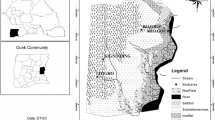Abstract
Palm Swamp Forests in the Caribbean region have been little studied although they are found in many countries. In Trinidad, they are an important component of the vegetation in the Nariva Swamp, a Ramsar site. The distribution and ecology of plants inRoystonea oleracea Palm Swamp Forest was studied using selected study plots. The forest had an open canopy with palms up to 26 m tall and a density of trees ≥10 cm dbh of 380 per hectare. TheRoystonea palm contributed 55.8% of individuals and was the most important of seven tree species ≥10 cm dbh. Seventy-four species were found, with most being understory shrubs and herbs. Peak ripe fruit availability was from August to November and was correlated with rainfall. The palm forest canopy appears to be relatively even aged, with lower non-palm trees giving an all-aged height and dbh distribution in the forest. The forest developed in conditions of low water levels, low salinity, and a hydroperiod that allows seed germination and seedling establishment during the early wet season. However, the forest undergrowth seems to be becoming dominated by terrestrial vegetation with palm seedlings unable to survive.
Similar content being viewed by others
Literature Cited
Aitken, T. H. 1973. Bush Bush Forest and Nariva Swamp. Journal of the Trinidad Field Naturalist’s Club 1:1–6.
Alvarez-Lopez, M. 1990. Ecology ofPterocarpus officinalis forested wetlands in Puerto Rico. p. 251–265.In A. E. Lugo, M. M. Brinson, and S. Brown (eds.) Forested Wetlands: Ecosystems of the World. Volume 15. Elsevier Publishers. Amsterdam, The Netherlands.
Bacon, P. R. 1988. Freshwater foodchains of Caribbean wetlands. Acta Cientifica 2:74–93.
Bacon, P. R. 1990. Ecology and management of swamp forests in the Guianas and Caribbean region. p. 213–248.In A. E. Lugo, M. M. Brinson, and S. Brown (eds.) Forested Wetlands: Ecosystems of the World. Volume 15. Elsevier Publishers, Amsterdam, The Netherlands.
Bacon, P. R., J. S. Kenny, M. E. Alkins, S. N. Mootoosingh, E. K. Ramcharan, and G. Seeberan. 1979. Studies on the Biological Resources of the Nariva Swamp. Trinidad, Zoology Department, University of the West Indies, St. Augustine, Trinidad. Occasional Papers No. 4.
Beard, J. S. 1946. The Natural Vegetation of Trinidad. Clarendon Press, Oxford, Great Britain.
Belcher, C. and G. D. Smooker. 1936. Birds of the colony of Trinidad and Tobago, Part 3. Ibis Series 14:1–35.
Brooks, R. L. 1935. Forests and forestry in Trinidad and Tobago. A statement prepared for the British Empire Forestry Conference, South Africa. Government Printer, Port of Spain, Trinidad.
Curtis, J. T. 1959. The Vegetation of Wisconsin. An Ordination of Plant Communities. University of Wisconsin Press, Madison, WI, USA.
Downs, W. G., T. H. Aiken, C. B. Worth, L. Spence, and A. H. Jonkers. 1968. Arbovirus studies in Bush Bush forest, Trinidad, West Indies, Sept 1954–Dec 1964. I. Description of the study area. American Journal of Tropical Medical Hygiene 17:224–236.
ffrench, R. P. 1991. A Guide to the Birds of Trinidad and Tobago (2nd edition). Cornell University Press, Ithaca, NY, USA.
ffrench, R. P. and M. ffrench. 1978. The wildest place of all. Trinidad Naturalist Magazine 2:28–31 & 34–35.
Herklots, G. H. C. 1961. The Birds of Trinidad and Tobago. Collins, London, Great Britain.
Holdridge, L. R., W. C. Grenke, W. H. Hatheway, T. Liang, and J. Tosi. 1971. Forest Environments in Tropical Lifezones. Pergamon Press, New York, NY, USA.
Junge, G. C. and C. F. Mees. 1958. The Avifauna of Trinidad and Tobago. Zoologische Verhandelingen 37, Leiden, The Netherlands.
Kalloo, M. B. 1975. A list of plants from Bush Bush Forest and the boat line of the Nariva Swamp. The National Herbarium, University of the West Indies, St. Augustine, Trinidad.
Marshall, R. C. 1934. Physiography and vegetation of Trinidad and Tobago. Oxford Forestry Memoirs 17:1–56.
Marshall, R. C. 1939. Silvicilture of the Trees of Trinidad and Tobago, British West Indies. Oxford University Press, London, Great Britain.
Myers, R. L. 1990. Palm Swamps. p. 267–285.In A. E. Lugo, M. M. Brinson, and S. Brown (eds.) Forested Wetlands, Ecosystems of the World: Volume 15. Elsevier Publishers Amsterdam, The Netherlands.
Nottebohm, F. and M. Nottebohm. 1969. The parrots of Bush Bush. Animal Kingdom 72:18–23.
Pool, D. J., A. E. Lugo, and S. C. Snedaker. 1975. Litter Production in mangrove forests of Southern Florida and Puerto Rico. p. 213–237.In G. Walsh, S. Snedaker, and T. H. Teas (eds.) International Symposium on Biology and Management of Mangroves. Vol. 1. Institute of Food and Agricultural Science, University of Florida, Gainesville, FL, USA.
Pool, D. J., S. C. Snedaker, and A. E. Lugo. 1977. Structure of mangrove forests in Florida, Puerto Rico, Mexico and Costa Rica. Biotropica 9:195–212.
Ramcharan, E. K. 1980. Floral History of the Nariva Swamp, Trinidad. Ph.D. Dissertation. University of the West Indies, St. Augustine, Trinidad.
Samuel, I. 1976. Enumeration survey (unpublished). Forestry Division, Ministry of Agriculture, Lands and Fisheries, Port of Spain, Trinidad.
Tikasingh, E. S. 1972. The Bush Bush Wildlife Sanctuary. p. 67–71.In P. R. Bacon and R. P. ffrench (eds.) The Wildlife Sanctuaries of Trinidad and Tobago. Ministry of Agriculture, Lands and Fisheries, Port of Spain, Trinidad.
Water Resources Agency. 1996. Unpublished rainfall and temperature data. Water Resources Agency. The Water and Sewage Authority, Port of Spain, Trinidad.
Wildlife Section. 1994–1996. Nariva Swamp Files (unpublished). Wildlife Section, Forestry Division, Ministry of Agriculture, Lands and Marine Resources, Port of Spain, Trinidad.
Author information
Authors and Affiliations
Rights and permissions
About this article
Cite this article
Bonadie, W.A. The ecology ofRoystonea oleracea palm swamp forest in the Nariva Swamp (Trinidad). Wetlands 18, 249–255 (1998). https://doi.org/10.1007/BF03161660
Received:
Revised:
Accepted:
Issue Date:
DOI: https://doi.org/10.1007/BF03161660




